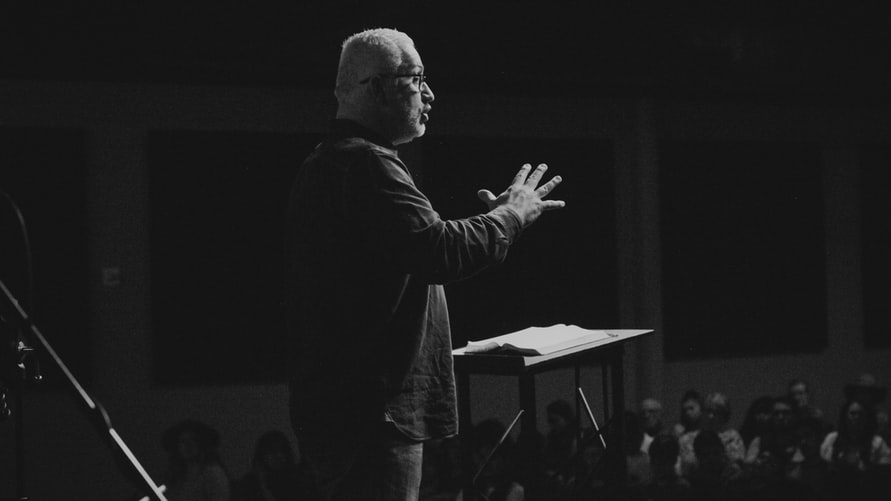Do you think it's hard to read from notes or a manuscript and still connect with your audience?
It isn't, really. All public speaking consists of someone sharing important information, and others listening. Given that fact, as a speaker you can't have a closer relationship with your notes or script than with your listeners. Right?
Your hands-on speaking skills are vital! Learn 101 easy-to-learn performance tips
in my book, How to Give a Speech. Discover an actors' secrets! Here it is on Amazon.
If you want to influence listeners, you must establish rapport right from the start. After all, are you persuaded by someone whose attention is elsewhere while they're talking to you?
Okay, let's get one thing out of the way. You don't have to, and shouldn't, memorize your speech. Yet you need to be able to gather ideas and phrases from a page quickly without breaking your contact with listeners. Below are six practical ways to do that. They work well whether you're using notes, a full manuscript, a PowerPoint deck, or other speaking aid.
Want to tell your story with PowerPoint while moving listeners to action? Download my Free cheat sheet, "5 Rules for Succeeding With PowerPoint." Rev up your PP performance!
How to Be a Speaker Not a Reader
1. Write to Speak. Compose your talk for the ears—not the eyes—of your listeners. Aim for the rhythms of conversation instead of the more formal style of memos and reports, and the slang and lazy habits of e-mail. Use simple words and short sentences. Listen to yourself on tape until you become crisp and concise. For inspiration, wrap your headphones around any speech by Winston Churchill. The idea is to converse, simply and honestly.
Do you have impact? When you're in the spotlight as a speaker, you're leading! Rock your audiences with my Free ebook, High-Impact Speaking: The Leader's Guide to Influence.
2. Make it Readable for Yourself. If you're using notes or a manuscript, make them easy to see from the lectern, table, or desktop. Use a 16-point, sans serif typeface, and triple-spacing. Avoid printing near the bottom of the page, or we'll see the top of your head too often. When you finish a page, slide that page face up on top of the page that preceded it. It's less distracting for your audience than if you flip the pages over in the air.
The words you say matter as well. Learn about the language that limits your success! Get my free white paper, "25 Words or Phrases to Avoid in Speeches and Presentations."
3. Grab Key Phrases: It's your listeners you want to spend time with, not your text. Learn how to look down and grab a key phrase or idea. Then look up and say it. Practice until you acquire a rhythm. Remember this rule: IF YOU'RE NOT LOOKING AT YOUR AUDIENCE, NOTHING SHOULD BE COMING OUT OF YOUR MOUTH. Resist the temptation to look for what's coming next while you're still talking about the current point.
4. Use 'The Pause That Refreshes'. That’s a slogan from an old soft drink ad. But it applies here because as a speaker you have to use pauses! They help shape your speech, and show that you’re confident enough to let an idea sink in. Pauses are refreshing, like an oasis in a desert. A speech without pauses seems to go on forever (like that desert). Combine this skill in pacing with my 5 key tools of vocal dynamics to be powerful as well as considerate.
5. Make Eye Contact. This is the forest that many speakers don’t see because of the trees that made up the pages of their manuscript. Get in the habit of looking up from your speech often. No, more often than that. Audiences need eye contact to believe you’re talking to them. So yes, eye contact is central to influence. And, especially, make your eye contact strong in your opening minute. Here's more advice on how to nail a presentation in 60 seconds.
6. Hit Your Peaks. Your speech needs shape in both its ideas and delivery. A speech without a climax, for instance, is as formless as an amoeba. And presentations without vocal variety are torture. The tendency of your voice to “flatten out” increases when you read from a text, rather than actually talking to listeners. Your job is to breathe life into those words. Your listeners will love you if you do that, and if you don't, wonder why you didn't show up.
Do you like mysteries and supernatural suspense? — Discover my Dr. William Scarlet Series.
Scotland Yard detective and psychic Dr. William Scarlet fights evil in 1880s London! — The three thrillers: Red Season, Year of the Rippers, The Master of Illusion. Click on the image!
You should follow me on Twitter here.

Gary Genard is an actor, author, and expert in public speaking and overcoming speaking fear. His company, The Genard Method offers live 1:1 Zoom executive coaching and corporate group training worldwide. He was named for nine consecutive years as One of the World’s Top 30 Communication Professionals, and also named as One of America's Top 5 Speech Coaches. He is the author of the Amazon Best-Sellers How to Give a Speech and Speak for Leadership: An Executive Speech Coach's Secrets for Developing Leadership Presence. His book, Fearless Speaking, was named in 2019 as "One of the 100 Best Confidence Books of All Time." " He is also the author of the Dr. William Scarlet Mysteries. Contact Gary here.





